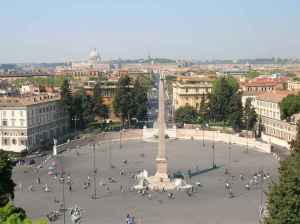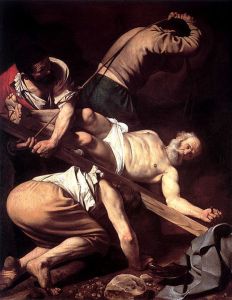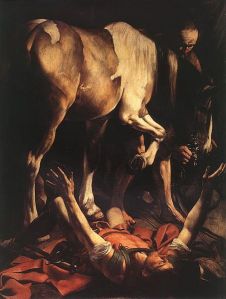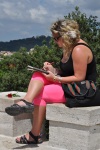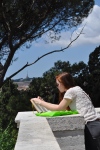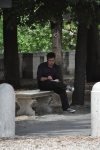For our final day in Italy we packed our sketchbooks and set off after breakfast for a day of immersion in Rome, walking the old city, viewing art and sketching. By subway we reached our first destination, Piazza del Popolo and the Basilica of Santa Maria del Popolo.
Originally built in the 11th century, the church contains two of the greatest paintings of Caravaggio, the Crucifixion of St. Peter, and the Conversion of St. Paul, still in the original locations for which they were commissioned. Santa Maria del Popolo also holds significant work by Raphael, Pinturicchio, and Annibale Caracci, as well as architectural features contributed during the Renaissance by Bramante (the apse) and in the Baroque period by Gian Lorenzo Bernini (the present day facade.)
From the Basilica we headed up to the Pincian hills above Piazza del Popolo where students worked on sketchbook studies of the urban spaces and street life. From there we followed a path through the old city that took us down the Spanish Steps, to the Trevi Fountain, and along the Tiber River to Castel Sant’Angelo where we caught a very crowded city bus (immersion in Rome?!) to Trastevere for lunch. Back at the hotel in the evening, our last in Italy, we all convened on the terrace of the hotel to reflect on our trip, share observations and suggestions for future trips.
Landscape Painting in Italy was first conceived as a vehicle for getting my most dedicated painting students out of their studio routines and habits, into a radically different culture, history, and visual space than any they were used to. I’ve often thought that an argument could be made that most of the significant changes in painting over the centuries have been the result of travel. Seeing new spaces and new conditions of light have a way of interrupting habitual modes of seeing and being, allowing a space for change. I chose Italy because it has played such a transformational role in landscape painting from the time of Corot and after, and its role is not as well known or celebrated as that of its northern neighbor, France. Looking back on the two weeks we all spent together, I couldn’t have hand-picked a stronger group of young painters. Against this foreign background, these students threw themselves courageously into the challenge of wrestling with this new landscape, and the exciting but often frustrating processes of working outdoors that it entailed. But perhaps the strongest impact of the trip was the increased camaraderie and empathy that the students felt for each other, and the deepening of friendships facilitated by experiences shared together in a strange land.
- Chelsea Dipman
- Tyler Travis and Hunter Long
- Tori Veach
- Sonja Petermann
- Danielle Muzina
- Alex Michener
- Frank Hobbs and Sally Livingston
- Katasha Ross, Logan Osbourne, Tori Veach
- Along the Tiber
- Along the Tiber
- Along the Tiber
- Cultural immersion? Tyler Travis, Maddie Mavec, Alex Michener.
- The group at the Spanish Steps
Photo credits: Rosy Avoscan, Chelsea Dipman, Frank Hobbs

